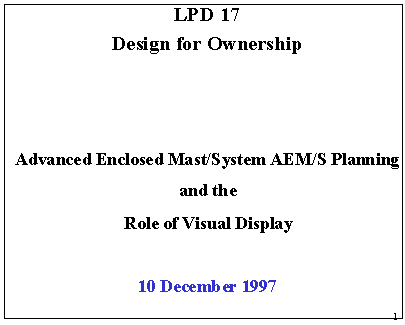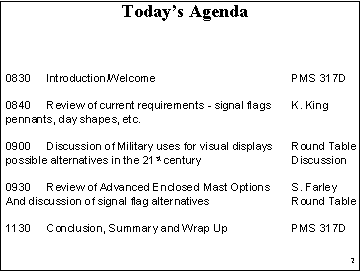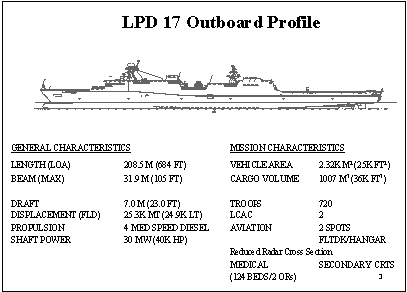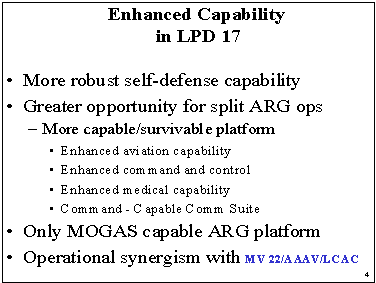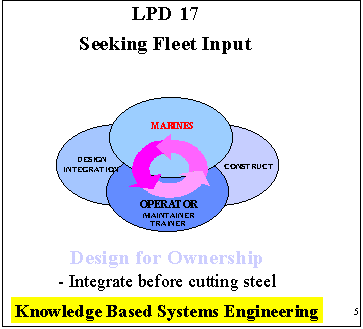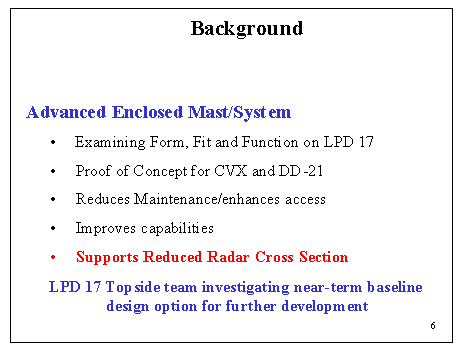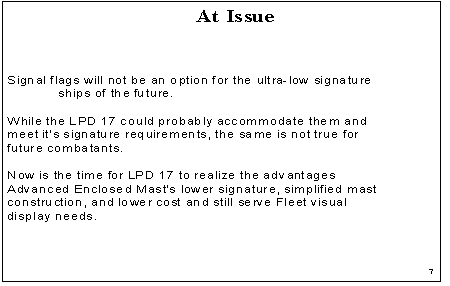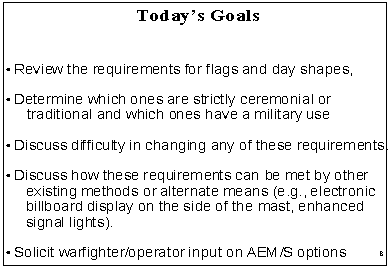 LPD-17
LPD-17 LPD-17
LPD-17|
|
|
LPD 17 Visual Display and
Advanced Enclosed Mast/Sensor System Workshop
10 December 1997
|
I. |
||
|
|
II. |
|
|
|
III. |
|
|
|
IV. |
|
|
|
V. |
|
|
|
A. |
|
|
|
B. |
|
|
|
C. |
On 10 December 1997, TEAM 17 hosted representatives from NAVSEA, NSWC-Carderock, Fleet Training Group, and COMPHIBGRU Two in the LPD 17 War Room at Expeditionary Warfare Training Group Atlantic to discuss current Navy and International visual display requirements aboard ship and their impact upon planning for the Advanced Enclosed Mast/Sensor System (AEM/S). This workshop is part of LPD 17’s Design for Ownership process where Fleet warriors, operators, maintainers and trainers contribute to ship design and system integration.
TEAM 17 is currently reviewing the applicability of the Advanced Enclosed Mast Sensor System and AEM/S optional designs for LPD 17. Intended to facilitate maintenance, limit corrosion and reduce radar cross section, the innovative shape and composition of the AEM/S will provide a significant upgrade to the LPD 17. As potential mast designs were reviewed, Team 17 recognized that a key variable in the design was the requirements for signal flags, pennants, day shapes, and dress ship in the 21st century. With a January deadline to select a near-term AEM/S baseline option, TEAM 17 scheduled this workshop.
Mr. John McIntire, NAVSEA 03D3/PMS 317D, initiated the workshop by outlining the goals as follows:
Discussion continued as Mr. Jeffrey Benson of NSWC briefed the attributes of the AEM/S, the rationale for its design, and background on its development and trials on USS ARTHUR W RADFORD. Team 17’s Kendall King outlined current visual display requirements and then facilitated discussion on projected needs. Mr. Lenny Wanex of NAVSEA 03W4H facilitated a discussion on the identification of performance requirements for alternative close-in tactical communications systems. Mr. Steve Farley of NAVSEA 03T1 concluded the formal presentations by outlining eight proposed design options for the Advanced Enclosed Mast/Sensor System.
The results of the workshop validated visual display requirements, established the need for LPD 17 to accommodate those requirements, and then centered upon a recommended design option for the Advanced Enclosed Mast/Sensor System. A port and starboard, deck mounted counterbalanced, hinged mast was recommended as the best option for LPD 17 to comply with current visual display requirements. The signal masts would only be raised when needed, enabling RCS reduction to be mandated. Future efforts should work toward developing technological solutions that alleviate the need for the current signal flag support structures so as to accommodate next-generation low signature ship designs.
One of the strengths in the planning and design of LPD 17 has been the input and support of Sailors and Marines. Good ideas and suggestions have been submitted and are now being considered for incorporation into the ship design. When the issue arose as to which baseline Advanced Enclosed Mast/Sensor System design option would best serve the future Sailors of LPD 17; Team 17 convened a Design for Ownership workshop. Hosted on 10 December 1997, representatives from NAVSEA, NSWC-Carderock, Fleet Training Group, and COMPHIBGRU Two met in the LPD 17 War Room at EWTGLANT to discuss current Navy and International visual display requirements aboard ship and their impact upon planning for the Advanced Enclosed Mast/Sensor System (AEM/S).
The Advanced Enclosed Mast/Sensor System is currently being tested aboard USS ARTHUR W. RADFORD and is being planned for inclusion on the LPD 17 Class. It is intended to reduce maintenance and enhance ship topside access, improve radar capabilities and support reduced radar cross section (RCS) – attributes that are desirable on LPD 17. As part of the planning for the mast, TEAM 17 has embarked upon an effort to examine form, fit and function on LPD 17 and to consolidate these efforts as a proof of concept for CVX and DD-21. Toward these ends the LPD 17 Topside team was required to investigate and then recommend a near-term baseline design option for further development by January 1998.
Participants from Fleet Training Group and COMPHIBGRU Two were invited during the workshop to review visual display requirements, help define and convey military and operational uses for these displays, and then assist in creating a AEM/S design that will serve LPD 17’s 21st Century needs. COMPHIBGRU Three also provided input. The agenda and the list of attendees are provided in Appendices A and B. The initial welcome/overview presentation is provided in Appendix C. Portions of the other presentations are included graphically in the Discussion section, Part III.
Welcome and Overview. Mr. John McIntire of NAVSEA PMS 317D/03D3 opened the session by providing background on the LPD 17 and its Design for Ownership (DFO) process. In design for ownership the planning and design of LPD 17 is dependent upon comments, suggestions, and recommendations from the Fleet and Marine Corps to ensure that the ship will meet their requirements and needs. The Visual Display and Advanced Enclosed Mast/Sensor System workshop is a typical example of TEAM 17 seeking Fleet input prior to choosing a baseline design option. In addition, he indicated that the session could also serve as a forum for beginning discussion about future technological solutions to visual signaling and displays.
Mr. McIntire reiterated the key issue for the workshop was that the use of conventional methods for displaying signal flags will probably not be an option for the ultra-low signature ships of the future due to the radar cross section of the structure from which the flags are flown. While the LPD 17 could accommodate display via current methods and meet it's signature requirements, the same may not be true for future combatants. Therefore now is the time for LPD 17 to realize the advantages that the Advanced Enclosed Mast offers of lower radar signature, simplified mast construction, and lower cost while still serving Fleet visual display needs.
Focusing on this issue, the goals of the workshop were outlined as follows:
AEM/S Background. Mr. Jeffrey Benson of NSWC – Carderock followed with an introduction to the Advanced Enclosed Mast/Sensor System and background on its testing aboard USS ARTHUR W RADFORD.
The design itself seeks to limit radar signature by shape (hexagonal shape and 10 degree slope) and enclosing key radar components. The mast is a large composite structure, 711/2 feet high and weighing 30 tons, whose structural integrity has been demonstrated by testing. The upper half of the mast is radar frequency transparent, permitting the transmission of selective radar frequencies and integrated communication energy through the mast’s surface. The lower half of the mast is radar reflective and the entire mast is part of an integrated EMI/EMP management system.
Testing to date on USS ARTHUR W RADFORD and lessons learned from the DDG-51 program has revealed payoffs in radar cross section reduction (RCSR). Exposed mast-mounted HM&E equipment, combat system and comms antennas dominate ship radar cross section. At the same time, radar-absorbing materials and structural shaping do not provide adequate RCS reduction. LPD 17’s stick mast and mast equipment accounts for 8% of the ship’s RCS while Applying AEM/S to the LPD 17 architecture will demonstrate "substantial reduction" in mast and mast Equipment RCS.
Figure 1 provides a baseline side view of the mast.
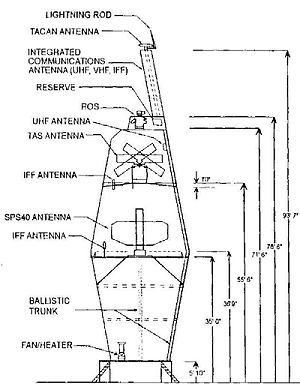
The resulting advantages to LPD 17 provided by the AEM/S appear to be substantial as concluded by Mr. Benson. These include the potential for meeting topside radar signature reduction goals and improving sensor performance while reducing maintenance. At the same time the AEM/S would reduce ownership costs by facilitating sensor upgrading and modernization over the 40-year service life of the class. All weather accessibility to mast sensor systems will also be an attribute to installing the AEM/S on LPD 17 as well as providing a proof of concept for CVX and DD-21.
The audience raised several questions at this point. (1) A cone shape was considered, but rejected for the AEM/S – a cone always gives a radar return while a faceted (hexagonal) shape will provide a lower signature median and only when the emitter is perpendicular to a specific facet or side. (2) Topside weight was a consideration and the differences between the stick and AEM/S mast is about an equal tradeoff. (3) The mast can be painted several times but the full number of coats to be applied before degradation of mast performance has not been determined. Embedded coloring was recommended. (4) There is a possible impact from stack gas residue, but cleaning systems, such as a semi-automatic sprinkler or hose system are being considered. (5) Component change out is facilitated by a mast detachable joint, i.e. that allows the top to be lifted off to replace a radar. The Advanced Enclosed Mast/Sensor System on LPD 17 is depicted in Figure 2.
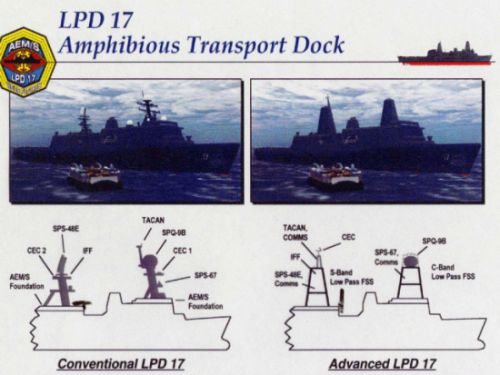
Figure 2. Advanced Enclosed Mast/Sensor System on LPD 17
One element of the AEM/S planning led to this workshop. The optimum mast design would not have a provision for signal halyards because such accessories detract from RCS reduction efforts. Therefore, how are visual display requirements on the AEM/S accommodated?
Visual Display Overview. During the workshop a mast visual display requirements presentation was provided. Refined by direct input from COMPHIBGRU Two and FTG operators, this overview was intended to establish requirements for visual displays, the references or source documents for those requirements, the impact on AEM/S (number of halyards), the identification of performance requirements for replacement systems, - and a possible recommendation on future shipboard visual signaling needs. The results of the presentation and associated dialogue led to Table 1.
|
Display |
Reference |
Requirement/Comments |
|
ENSIGN |
NTP 13/Navy Regs |
Flown from Single halyard from Foremast. Required for near land operations and battle |
|
COMMISSIONING PENNANT |
NTP 13/Navy Regs |
Semi-permanent display from aft mast – replaced by personal flag |
|
UNION JACK |
Navy Regs |
Flown from yardarm when general court martials and courts of inquiries held onboard ship |
|
PERSONAL FLAG |
NTP 13/Navy Regs |
Replaces commissioning pennant when ARG commander., flag officer, etc., embarked |
|
AWARD FLAGS |
NTP 13 |
Single Halyard PUC,NUC, MUC and Battle E are already displayed on bridge wings. Energy Conservation and Environmental flags, etc. are not. |
|
ABSENTEE PENNANTS |
NTP 13 |
Up to 3 separate halyards. Sometimes not used as counter terrorism precaution – 6th Fleet |
|
CHURCH/JEWISH WORSHIP PENNANT |
NTP 13/Navy Regs Public Law |
Single halyard as Ensign Flown when chaplain onboard conducting church or Jewish worship services |
|
PREP |
NTP 13/ATP 1 |
Single halyard - for colors |
|
DRESS/FULL DRESS |
NTP 13/Navy Regs |
Ensigns flown from each masthead. Need attachments to mast for Full Dress ship |
|
FOREIGN ENSIGN |
NTP 13 |
Single halyard from mast for ceremonies in foreign ports |
|
STBD (SOPA) |
NTP 13/ATP 1 |
Used Inport – as indication for senior officer present afloat |
|
Day Shapes |
COLREGS-Inland Rules |
Where best seen –maximum halyards for underwater ops. Merchant ships use pole placed on foc’sle |
|
International Code of Signals |
PUB102 |
Publication exempts warships, but remains internationally recognized signals – up to two halyards required. |
|
Treaty Signals |
INCSEA |
Requires 2 Halyards YVI Other treaties require Ensign |
|
Tactical |
ATP I VOL II- |
Required 3 Halyards (5 Flags) |
|
|
ATP II VOL II |
Required (convoy) 1 Halyard |
|
|
ACP 113/131 |
Same as ATP I Vol. II |
Visual Display Conclusions: In examining the implications of Table 1, the group came to the following consensus for LPD 17. If only the minimum number of halyards were installed, the ship design would need to allow for:
Discussion also included input on operational usage of signal flags. COMPHIBGRU Two and FTG representatives as well as comments submitted by COMPHIBGRU Three established the need for retaining the use of signal flags for tactical reasons and for communications with Allies, Friendly, and Partners in Peace navies. Although it was understood that such visual displays may eventually become outdated as future low RCS signature 21st century ships enter service, the LPD 17 may very well have to be a transition ship – accommodating visual display until the capability is replaced.
For instance, in a swept channel/port entry/sortie, daylight transit signal flags remain a viable means of tactical maneuvering communications during electronic silence. It remains the fastest means for silent communications that is fully understood by all navies, without language interpretation challenges. The consensus of the workshop was that signal flags remain a requirement for the LPD 17 class design until alternative means are uniformly accepted internationally.
The workshop also addressed other visual display requirements currently in use that may not be essential. Each is a candidate for further consideration and possible initiatives to change the requirements as follows:
Note: A sufficient change to ATP 1 might be to make certain displays, (e.g. absentee indicators) optional, rather than to delete the meanings or the use of these flags all together.
A brief discussion was led by NAVSEA 03W4H to determine rough performance requirements for visual display replacement systems. Based on our current capabilities with signal flags, the replacement systems would have to:
An optimum replacement would be one that could be sent from a keyboard, could be automatically detected by a sensor on the receiving ship and receipted for, automatically decoded and displayed without human intervention, visible at longer ranges both day and night (and all weather), and have reduced counter-detection. Such a system could be used to replace signal flags as well as flashing light communications, but it would have to be readily compatible or transferable to Allied and Friendly navies.
Design Discussion. Mr. Steve Farley, NAVSEA 03T1, concluded the presentations with an overview of the AEM/S design options. Pros and cons for each option were also presented. The resulting discussion of each item led to a recommended option for LPD 17. Three comments were expressed as designs were considered: (1) The ship will not always need minimum RCS (inport, etc.); and (2) At times when minimum RCS is required the need for electronic silence and visual signaling and communications (as a substitute for electronic communications) will be paramount; (3) That signal flags, pennants, day shapes, and halyards were not RCS offenders – rather the support structure (i.e. yardarms, masts, etc.) required for their display were the offenders.
|
OPTION 1 - Deletion of Flags Advantages
|
|
|
Issues
|
|
|
Workshop Conclusion
|
|
|
OPTION 2 – Fixed Yardarms Advantages
|
|
|
Issues
|
|
|
Workshop Conclusion
|
|
|
OPTION 2A – Telescoping Yardarms Advantages
|
|
|
Issues
|
|
|
Workshop Conclusion
|
|
OPTION 3 – Hoist Method Advantages
|
|
|
Issues
|
|
|
Workshop Conclusion
|
|
|
OPTION 4 – Fixed Masts Advantages
|
|
|
Issues
|
|
|
Workshop Conclusion
|
|
|
OPTION 4A - Telescoping Masts Advantages
|
|
|
Issues
|
|
|
Workshop Conclusion
|
|
|
OPTION 5 – Mast Face Hoists Advantages
Issues
|
|
|
|
|
Workshop Conclusion
|
|
|
OPTION 6 – Projected Images Advantages
|
|
|
|
|
Issues
Workshop Conclusion
|
|
|
Preferred Option - OPTION 4B – Hinged (Lowering/Raising) Masts Advantages
|
|
Issues
Workshop Conclusion
|
|
The following conclusions were derived from the workshop:
B. Advanced Enclosed Mast/Sensor System on LPD 17 Advantages
C. Current Minimum Visual Display Requirements on LPD 17
D. Necessity for Signal Flags
E. Necessity for Day Shapes
F. Future Visual Display Requirements
Union Jack from the yardarm
Award flags
Absentee Pennants/SOPA
PREP for colors
Alleviation of current signal flag support structure through development of alternative close-in signaling capability is desired. Replacement systems would have to meet the following requirements:
An optimum replacement would be one that could be sent from a keyboard, could be automatically detected by a sensor on the receiving ship and receipted for, automatically decoded and displayed without human intervention, visible at longer ranges both day and night (and all weather), and have reduced counter-detection. Such a system could be used to replace signal flags as well as flashing light communications, but it would have to be readily compatible or transferable to Allied and Friendly navies.
Merchant ships use day shape poles. This or some similar other system where provisions for rigging/staging day shapes when needed is a possibility. Daytime lights (for instance, a daytime strobe for restricted in ability for maneuver) with greater visibility might be another possibility.
Treaty/INCSEA/International Code of Signals may require as many as three halyards. Efforts should be made to simplify these signals, exclude war ships from compliance (as is already done in some cases) or to permit VHF Bridge-to-Bridge VHF communications as a means to convey information previously conveyed by signal flags.
G. Advanced Enclosed Mast/Sensor System Options
LPD 17 Visual Display and Advanced Enclosed Mast/Sensor System Workshop Agenda 10 December 1997
|
0830 Introduction/Welcome |
J. McIntire, PMS 317D |
|
0850 Overview of Advanced Enclosed Mast/ System Development |
J. Benson, NSWC-CD |
|
0930 Identification of performance requirements for alternative close-in tactical communications systems. |
L. Wanex NAVSEA 03W4H |
|
0910 Review of requirements relating to signal flags, pennants and day shapes and visual communications requirements (Includes COLREG Requirements) |
K. King, Ownership Team (Team 17) |
|
1000 Military uses for signal flags, et al and possible alternatives in the 21st century |
Round Table Discussion |
|
1030 Review of Advanced Enclosed Mast Options For LPD |
S. Farley, NAVSEA RCS Engineer |
|
1100 Discussion of signal flag alternatives and Mast design options |
Round Table Discussion |
|
1145 Summary and Wrap up |
J. McIntire, PMS 317D |
LPD 17 HOME PAGE http://lpd17.nswc.navy.mil
LPD 17/EWTGLANT Warroom: Phone 1-800-445-1916, Fax 757-464-8599
WORKSHOP
Attendees
10 December 1997
|
NAME |
ORG |
PHONE# |
FAX# |
|
|
|
|
|
|
|
|
Benson, Jeff |
NSWC Team 17 |
(301) 227-1087 |
-1020 |
|
|
Berrios, Gilberto SMC |
FTG |
(757) 363-4151 |
|
|
|
Boozer, Joe SMCS |
FTG |
(757) 363-4151 |
|
|
|
Campbell, Wink |
ASC |
(757) 464-8604 |
464-8599 |
|
|
Casper, Robert, Lt |
CPG-2 |
(757) 464-8677 |
|
|
|
Erikson, Mark CDR |
N8 CPG-2 |
(757) 464-8699 |
|
|
|
Farley, Steve |
NAVSEA 03T1 |
(207) 442-5284 |
|
|
|
Hungerford, Milo QMC |
FTG |
(757) 363-4809 |
|
|
|
Jones, Betty |
A&T, Team 17 |
(703) 418-8690 |
-8651 |
|
|
King, Kendall |
ASC, Team 17 |
(757) 424-3711 |
420-6910 |
k_king@asc.livenet.net |
|
Lorenzawa, Richard |
QMCS FTG |
(757) 363-4809 |
|
|
|
Luebke, Bill CAPT |
PMS 317 |
(703) 413-4999 |
418-2527 |
|
|
Marsh, Robert SMC |
FTG |
(757) 363-4151 |
|
|
|
McIntire, John |
NAVSEA 03D3 |
(504) 437-3542 |
|
|
|
Picotte, Len |
ASC, Team 17 |
(757) 424-3711 |
|
Picotte.Len@ascacc.com |
|
Rockwood, James |
CPG-2 |
(757) 464-8815 |
|
|
|
Wanex, Lenny |
NAVSEA 03W4H |
(703) 602-1895 |
-4746 |
|
|
Weingart, Steve CDR |
FTG OIC |
(757) 464-8888 |
|
Welcome and Overview Presentation
